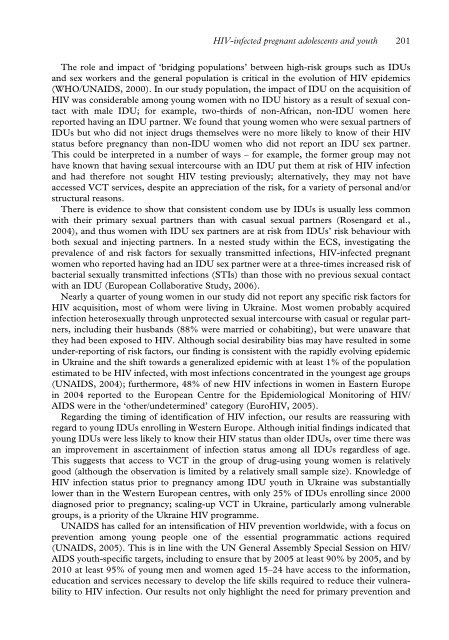“FEDERICO II” UNIVERSITY OF NAPLES PhD Program ... - FedOA
“FEDERICO II” UNIVERSITY OF NAPLES PhD Program ... - FedOA
“FEDERICO II” UNIVERSITY OF NAPLES PhD Program ... - FedOA
Create successful ePaper yourself
Turn your PDF publications into a flip-book with our unique Google optimized e-Paper software.
HIV-infected pregnant adolescents and youth 201<br />
The role and impact of ‘bridging populations’ between high-risk groups such as IDUs<br />
and sex workers and the general population is critical in the evolution of HIV epidemics<br />
(WHO/UNAIDS, 2000). In our study population, the impact of IDU on the acquisition of<br />
HIV was considerable among young women with no IDU history as a result of sexual contact<br />
with male IDU; for example, two-thirds of non-African, non-IDU women here<br />
reported having an IDU partner. We found that young women who were sexual partners of<br />
IDUs but who did not inject drugs themselves were no more likely to know of their HIV<br />
status before pregnancy than non-IDU women who did not report an IDU sex partner.<br />
This could be interpreted in a number of ways – for example, the former group may not<br />
have known that having sexual intercourse with an IDU put them at risk of HIV infection<br />
and had therefore not sought HIV testing previously; alternatively, they may not have<br />
accessed VCT services, despite an appreciation of the risk, for a variety of personal and/or<br />
structural reasons.<br />
There is evidence to show that consistent condom use by IDUs is usually less common<br />
with their primary sexual partners than with casual sexual partners (Rosengard et al.,<br />
2004), and thus women with IDU sex partners are at risk from IDUs’ risk behaviour with<br />
both sexual and injecting partners. In a nested study within the ECS, investigating the<br />
prevalence of and risk factors for sexually transmitted infections, HIV-infected pregnant<br />
women who reported having had an IDU sex partner were at a three-times increased risk of<br />
bacterial sexually transmitted infections (STIs) than those with no previous sexual contact<br />
with an IDU (European Collaborative Study, 2006).<br />
Nearly a quarter of young women in our study did not report any specific risk factors for<br />
HIV acquisition, most of whom were living in Ukraine. Most women probably acquired<br />
infection heterosexually through unprotected sexual intercourse with casual or regular partners,<br />
including their husbands (88% were married or cohabiting), but were unaware that<br />
they had been exposed to HIV. Although social desirability bias may have resulted in some<br />
under-reporting of risk factors, our finding is consistent with the rapidly evolving epidemic<br />
in Ukraine and the shift towards a generalized epidemic with at least 1% of the population<br />
estimated to be HIV infected, with most infections concentrated in the youngest age groups<br />
(UNAIDS, 2004); furthermore, 48% of new HIV infections in women in Eastern Europe<br />
in 2004 reported to the European Centre for the Epidemiological Monitoring of HIV/<br />
AIDS were in the ‘other/undetermined’ category (EuroHIV, 2005).<br />
Regarding the timing of identification of HIV infection, our results are reassuring with<br />
regard to young IDUs enrolling in Western Europe. Although initial findings indicated that<br />
young IDUs were less likely to know their HIV status than older IDUs, over time there was<br />
an improvement in ascertainment of infection status among all IDUs regardless of age.<br />
This suggests that access to VCT in the group of drug-using young women is relatively<br />
good (although the observation is limited by a relatively small sample size). Knowledge of<br />
HIV infection status prior to pregnancy among IDU youth in Ukraine was substantially<br />
lower than in the Western European centres, with only 25% of IDUs enrolling since 2000<br />
diagnosed prior to pregnancy; scaling-up VCT in Ukraine, particularly among vulnerable<br />
groups, is a priority of the Ukraine HIV programme.<br />
UNAIDS has called for an intensification of HIV prevention worldwide, with a focus on<br />
prevention among young people one of the essential programmatic actions required<br />
(UNAIDS, 2005). This is in line with the UN General Assembly Special Session on HIV/<br />
AIDS youth-specific targets, including to ensure that by 2005 at least 90% by 2005, and by<br />
2010 at least 95% of young men and women aged 15–24 have access to the information,<br />
education and services necessary to develop the life skills required to reduce their vulnerability<br />
to HIV infection. Our results not only highlight the need for primary prevention and
















